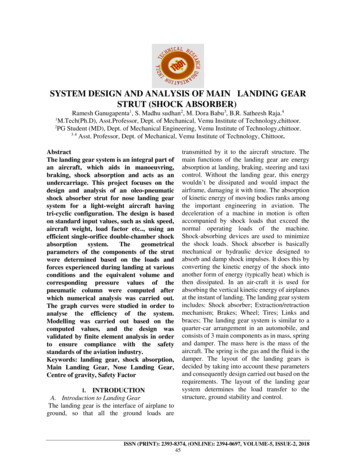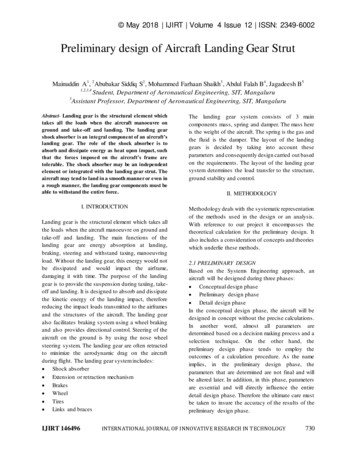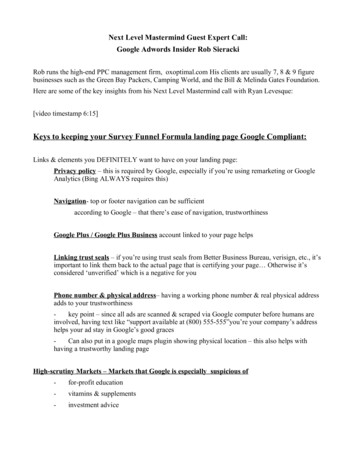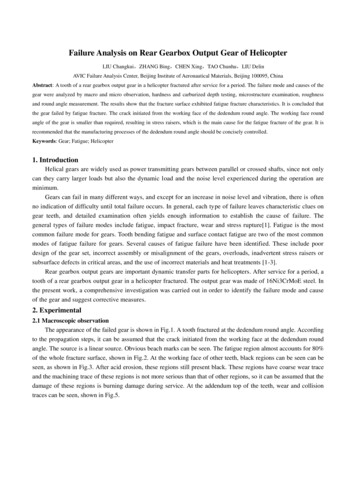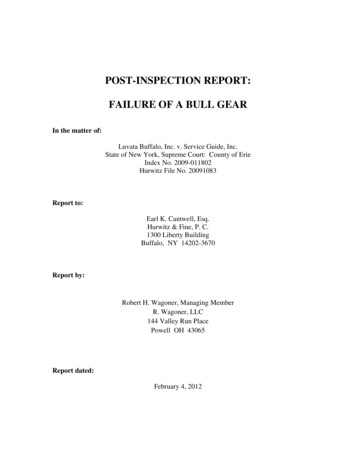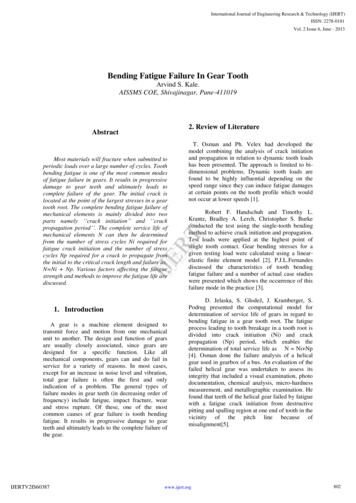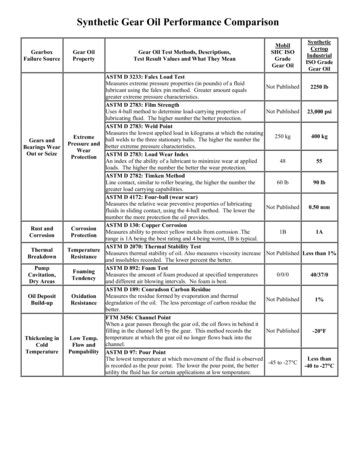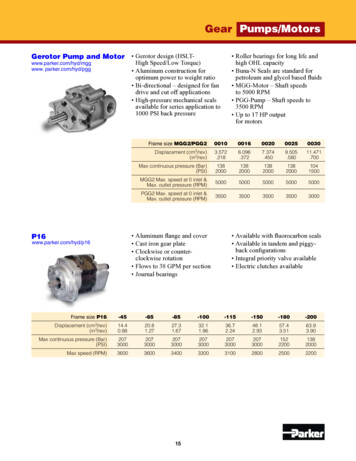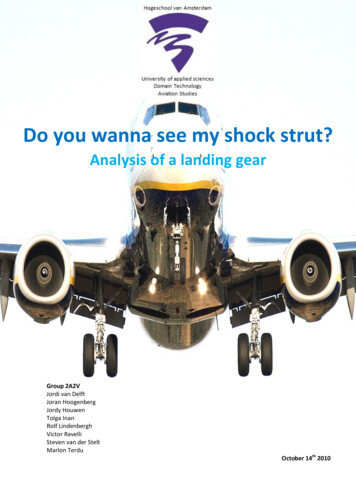
Transcription
Hogeschool van AmsterdamAviation StudiesDo you wanna see my shock strut?Analysis of a landing gearGroup 2A2VJordi van DelftJoran HoogenbergJordy HouwenTolga InanRolf LindenberghVictor RavelliSteven van der SteltMarlon TerduOctober 14th 2010
Hogeschool van AmsterdamAviation StudiesTable of contentsSummary. . 1Introduction. . 21.Landing gear analysis . 31.1.Introduction landing gear .31.1.1.Purposes and goals .31.1.2.Configuration .31.2.Shock absorbing and damping .51.2.1.Shock strut and torque links .61.2.2.Air/ground logic .71.3.Maneuvering on the ground .91.3.1.Wheels and tires .91.3.2.Nose landing gear steering system.111.4.Extension and retraction .121.4.1.Landing gear control system .121.4.2.Main landing gear extension and retraction system .131.4.3.Nose landing gear extension and retraction system .151.4.4.Landing gear position indication and warning system .171.5.Deceleration .171.5.1.Hydraulic brake system .181.5.2.Auto brake system .181.5.3.Antiskid system.191.5.4.Parking brake system .201.6.Regulations .201.6.1.Boeing’s operational requirements .201.6.2.Authorities’ requirements .211.6.3.Master Minimum Equipment List (MMEL) .252.Mechanical analysis. 262.1.Basic theory mechanics, free body diagrams and geometry .262.1.1.Basic theory mechanics .262.1.2.Free body diagrams .272.2.Design and materials .282.2.1.Design .282.2.2.Materials.292.3.2.3.1.Forces and moments .29Taxi .30
Hogeschool van AmsterdamAviation Studies2.3.2.Rejected take-off .302.3.3.Landing .312.4.Constructional stress .312.4.1.Stress .312.4.2.Stress calculations on the critical parts .322.5.3.Conclusion .33Operational analysis . 343.1.Current maintenance plan.343.1.1.Scheduled maintenance .343.1.2.Unscheduled maintenance .353.2.Hydraulic failure .353.2.1.Failures .353.2.2.Influence airworthiness .363.2.3.Solutions .363.2.4.Prevention .363.3.Wheel failure .363.3.1.Failure .363.3.2.Influence airworthiness .363.3.3.Solutions .373.3.4.Prevention .373.4.Financial analysis .373.4.1.Malfunction costs .373.4.2.Benefits .383.5.Conclusion .39Bibliography. . 40List of appendices. . 43
Hogeschool van AmsterdamAviation StudiesSummaryThe landing gear is a decisive part of an aircraft. The main purposes are absorbing the landing pulse, maneuveringon the ground and providing safe aircraft operations. All the landing gears have the same purposes, but there area lot of landing gear configurations. The different types of configurations are: conventional gear, single mainwheel, bicycle gear, tricycle gear, quadricycle gear and multi-bogey gear. The Boeing 737-800 NG has a tricyclegear. Because the aircraft has a tricycle gear, the gear divides the forces on a bigger surface. Small aircraft oftenhave a fixed landing gear, civil aircraft often a retractable landing gear. In order to gain better aerodynamicconditions and higher efficiency, civil aircraft have retractable landing gears. One of the purposes of theair/ground system is that it makes sure that the landing gear does not retract on the ground. When the landinggear is retract, it is automatically locked, so the gear cannot ‘fall out’ of the storage. In case of emergency, thepilot can extend the landing gear manually. The air/ground system also gives warnings when a malfunction occursin the system. To absorb the landing shock, shock struts are used. These absorb most of the landing forces byusing a compressible gas for suspension and oil for damping. The tires also absorb a bit of the landing pulse.When the aircraft touches down, the aircraft needs to slow down its speed. To slow down the aircraft, the aircraftuses brakes. During full apply of the brakes, they incline to skid. To prevent this, an anti-skid system is used. Tomaneuver on the ground, a nose wheel steering system is used. Also, to control the landing gear safely, and sothe whole aircraft, Boeing has its own requirements. Boeing also published a Master Minimum Equipment List(MMEL), this list prescribed which parts a new landing gear minimally must have for safe operations. Not onlyBoeing has its requirements, also the European Aviation Safety Agency (EASA) has regulations. It formsregulations to grant aircraft a certification of airworthiness.Whenever an aircraft lands, takes off, is in a static situation or taxis, different forces are acting on the landinggear. To calculate the amount of force on the landing gear, it is necessary to determine the forces in the criticalparts of the landing gear and during ground movements. In order to choose the right construction and materials,it is necessary to perform research. Also inner forces (stress) are applied on the landing gear. These are the forcesacting inside the area of the section. After calculating all situations accurately and with a focus on the design andmaterials, the rejected take-off has proven to be the situation which causes the most stress on the landing gear.After studying the maintenance program, two malfunctions, which can occur in the landing gear, are chosen. Thetwo chosen malfunctions are the hydraulic and wheel malfunction. The influence on the airworthiness must beexamined to prevent the malfunction in the future. When a failure occurs, it must be solved. When a problemoccurred and the aircraft is back on the ground, the maintenance crew need to repair the failure and how toprevent it in the future. The financial analysis is an overview of the costs and benefits after adapting themaintenance plant. The extra costs are 707,200 when the maintenance plan is not adapted. So, the benefits arethe advantages of the reduction of the operational and material costs.2A2VReport “Landing Gear”Page 1
Hogeschool van AmsterdamAviation StudiesIntroductionProject team 2A2V is given the instruction by ALA to analyze a landing gear of a modern aircraft and conducting aresearch into possible malfunctions of the landing gear.This project has some limiting conditions. The team has seven weeks to finish this project. After those sevenweeks, on Thursday the 14th of October, a report must be handed over. This report must have a minimum of30 pages and a maximum of 40 pages. This report consists of three chapters, each of the chapters describe a partof the research process.In order to start the project, the group chooses the Boeing 737-800 NG as the aircraft to analyze. To understandthe principle of the landing gear, the main landing gear and the nose landing gear constructions are processed.The subsystems such as the braking system and the air/ground are convenient to get an overvi
31.07.2010 · using a compressible gas for suspension and oil for damping. The tires also absorb a bit of the landing pulse. When the aircraft touches down, the aircraft needs to slow down its speed. To slow down the aircraft, the aircraft uses brakes. During full apply of the brakes, they incline to skid. To prevent this, an anti-skid system is used. To
